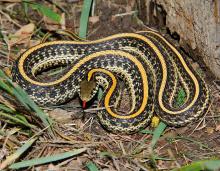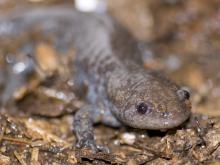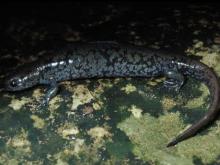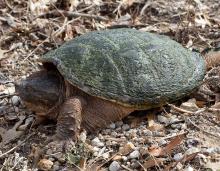Reptiles and Amphibians
Media

Species Types
Scientific Name
Thamnophis radix
Description
A medium-sized, striped snake of wet prairies and marshes, the plains gartersnake occurs mainly in Missouri's north-central and northwestern counties, with isolated populations in and west of the St. Louis area.
Media

Species Types
Scientific Name
Ambystoma talpoideum
Description
The mole salamander is broad-headed, dull gray or brown, with a small body and tail and large limbs. It spends almost all its time below ground. In Missouri, it is restricted to the lowlands of our southeastern counties.
Media

Species Types
Scientific Name
Ambystoma tigrinum
Description
Tiger salamanders occur statewide. They spend most of their time underground, often in burrows made by small mammals or under logs and rocks. Your best chance of seeing a tiger salamander is at night after a heavy rain.
Media

Species Types
Scientific Name
Ambystoma texanum
Description
The small-mouthed salamander is a medium-sized, dark gray to black or dark brown salamander with a small head and mouth. In Missouri, it’s found nearly statewide — but not in the Ozarks.
Media

Species Types
Scientific Name
Terrapene ornata
Description
The ornate box turtle usually has four hind toes. Its high-domed shell is usually smooth on top, lacks a ridge, and is brown with yellow lines. Look for it in grassy habitats.
Media

Species Types
Scientific Name
Kinosternon flavescens
Description
The yellow mud turtle is a small, uniformly colored, semiaquatic turtle restricted to certain counties in west-central, northeastern, and southwestern Missouri. It is an endangered species in our state.
Media

Species Types
Scientific Name
Chelydra serpentina
Description
A large aquatic turtle with a big pointed head, long thick tail, and small lower shell, the eastern snapping turtle is common throughout the state, anywhere there is permanent water.
Media

Species Types
Scientific Name
Storeria dekayi
Description
Dekay's brownsnake is a small, secretive species that prefers moist environments. It can be gray to brown to reddish brown. It usually has a tan stripe running down the back, bordered by two rows of small brown spots. The top of the head is usually dark. Occurs statewide.
Media

Species Types
Scientific Name
Pseudacris fouquettei
Description
The Cajun chorus frog is a small tan to brown frog with dark dorsal stripes that are narrow or often broken into a series of dashes or spots. It occurs in a few counties in southeastern Missouri.
See Also
About Reptiles and Amphibians in Missouri
Missouri’s herptiles comprise 43 amphibians and 75 reptiles. Amphibians, including salamanders, toads, and frogs, are vertebrate animals that spend at least part of their life cycle in water. They usually have moist skin, lack scales or claws, and are ectothermal (cold-blooded), so they do not produce their own body heat the way birds and mammals do. Reptiles, including turtles, lizards, and snakes, are also vertebrates, and most are ectothermal, but unlike amphibians, reptiles have dry skin with scales, the ones with legs have claws, and they do not have to live part of their lives in water.





















